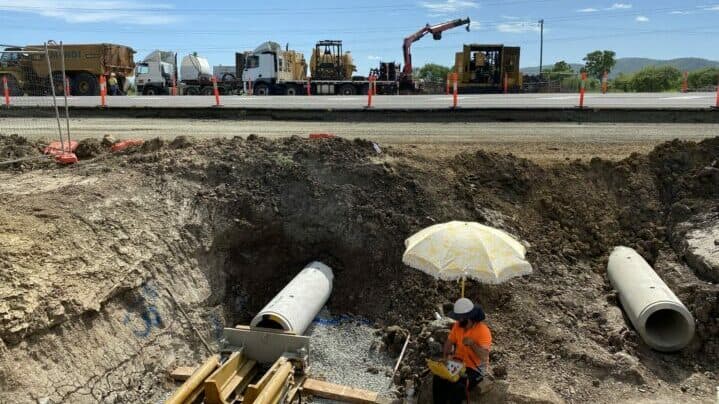Heading into the wet season in northern Queensland, Edge Underground was working against extreme heat and flash flooding on a microtunnelling project to complete three lines – with one under a major state highway. Fighting against the elements and upcoming holidays, planning played a major role in ensuring the success of the project, so that when the worst scenario occurred, Edge Underground could perform its best and get the job done on time.
Edge Underground was subcontracted to complete three microtunnels in Townsville, partnering with Mendi Constructions, a well-known local business. The job required a 450DN, 500DN and 600DN concrete enveloper pipe to be installed – the small two pipes under one road, and the biggest and longest pipe under the Bruce Highway.
Difficult weather conditions
Stuart Harrison, Managing Director at Edge Underground, said going into the project, the team knew that there could be challenges due to the extreme heat, and timing meant that Queensland was heading into the wet season, presenting the risk of flash flooding.
The team was also aware that there was a learning curve for Mendi Constructions, as their crew had little experience with microtunnelling and needed a partner that could help them process what was important to ensure the best outcome for the project.
As the team was getting started on the project to install the 450DN pipe, the worst case scenario happened, with three days of flash flooding stopping work before they were able to get momentum on the project.
“The flash flooding really set the foundation for understanding the need to get the shaft prepared for all weather, and assume and plan for the worst as that will definitely allow you to perform at your best,” Mr Harrison said.
“With the first shaft we had to make some compromises, and in this industry, whenever a compromise is made, it eventually catches up to you during the project. If it doesn’t catch up with you, you’re very lucky.
“We don’t like to rely on luck to perform well, so we pre-plan and manage the risk in order to ultimately be able to provide a high-end final product.”
Mr Harrison said the flooding made the job more complicated, and increased the scope of work and timeframe to complete it.
However, with the lessons learned from line one, the team was able to compete the pilot and ream line two without problems.
“The bore process was a total of two days of work, which was amazing considering the volume of material,” Mr Harrison said.
“And like all the jobs we complete, the pipe was installed within millimetres of the required grade.”
Tackling challenges
As well as difficult weather conditions, the team was presented with delays from the Christmas break and changing ground conditions mid-bore.
Mr Harrison said the timing to start bore three was in the lead up to the Christmas break, so there was going to be a number of days where work wouldn’t be taking place.
“There was a concern that maybe we shouldn’t start before Christmas, but we felt we had the ability to get it done and that if we started on Wednesday, we could finish it by Thursday night. This would be a great outcome for a 600DN concrete enveloper pipe with a 800mm bore,” Mr Harrison said.
“It did get a bit complicated when we launched on Wednesday as we found there was a change in ground conditions mid-bore. It went from hard consolidated to more alluvial, and the alluvial layer was allowing high water flow across the compacted clay – which wasn’t noted in the geotech.
“However, with the AXIS laser guided boring system we can adapt the setup to best suit conditions, so we were able to readjust our setup and complete the pilot line on Wednesday, allowing us to start reaming Thursday morning.
“While there were some delays out of our control during the ream, we completed the drill on Thursday night, and the project was finished well within the timeframes leading into Christmas.”
Lending experience
Mr Harrison said it can be hard in projects such as these to guide contractors with little experience with microtunnelling to make good decisions that reduce risk without being perceived as arrogant.
“When we feel it is necessary for the project, we try to highlight the need to spend a little more money in advance rather than pay heavily throughout the construction project,” Mr Harrison said.
“And we saw this in action with this project; bore one was undertaken with the pay-as-we-go approach, but bore two and three were quite seamless due to the pre-planning and commitment from everyone to understand the risks and minimise them so the project could be completed in the short timeframe leading into Christmas.
“To everyone else, bores two and three appeared to be uncomplicated but in reality there was a lot of work that went into their smooth completion.”

